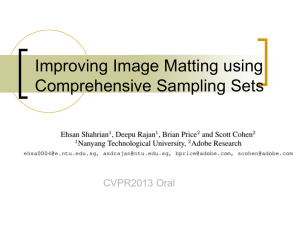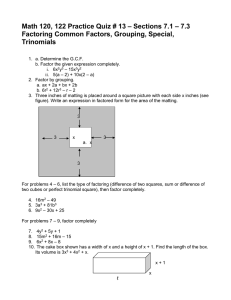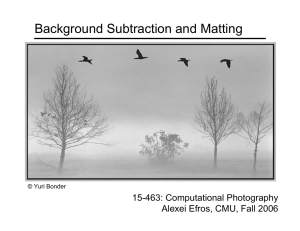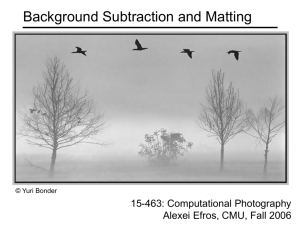New course focus
advertisement
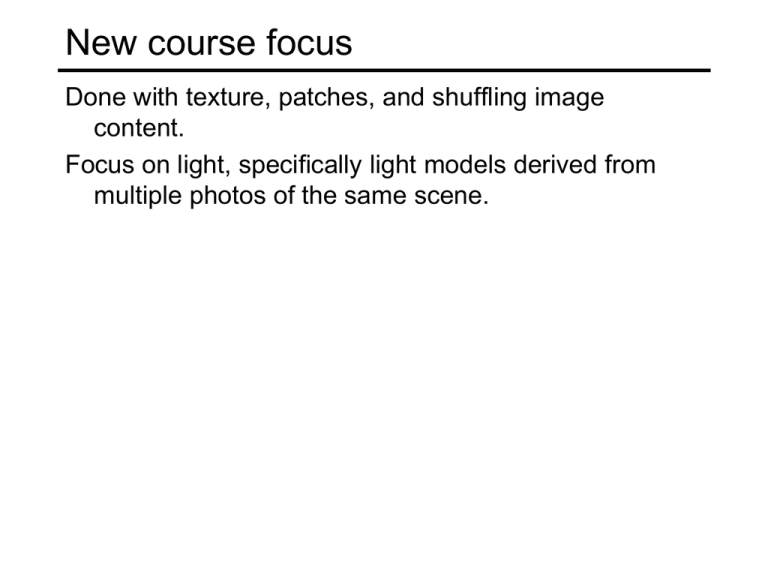
New course focus Done with texture, patches, and shuffling image content. Focus on light, specifically light models derived from multiple photos of the same scene. Matting, Transparency, and Illumination Slides from Alexei Efros cs129: Computational Photography James Hays, Brown, Spring 2011 How does Superman fly? Super-human powers? OR Image Blending (project 2) OR Image Matting? Physics of Alpha Matting Semi-transparent objects Pixels too large alpha channel Add one more channel: • Image(R,G,B,alpha) Sprite! Encodes transparency (or pixel coverage): • Alpha = 1: • Alpha = 0: • 0<Alpha<1: opaque object (complete coverage) transparent object (no coverage) semi-transparent (partial coverage) Example: alpha = 0.7 Partial coverage or semi-transparency “Pulling a Matte” Problem Definition: • The separation of an image C into – A foreground object image Co, – a background image Cb, – and an alpha matte a • Co and a can then be used to composite the foreground object into a different image Hard problem • Even if alpha is binary, this is hard to do automatically (background subtraction problem) • For movies/TV, manual segmentation of each frame is difficult • Need to make a simplifying assumption… Average/Median Image What can we do with this? Background Subtraction - = Background Subtraction A largely unsolved problem… One video frame Estimated background Difference Image Thresholded Foreground on blue Blue Screen Blue Screen matting Most common form of matting in TV studios & movies Petros Vlahos invented blue screen matting in the 50s. His Ultimatte® is still the most popular equipment. He won an Oscar for lifetime achievement. A form of background subtraction: • Need a known background • Compute alpha as SSD(C,Cb) > threshold – Or use Vlahos’ formula: a = 1-p1(B-p2G) • Hope that foreground object doesn’t look like background – no blue ties! • Why blue? • Why uniform? The Ultimatte p1 and p2 Semi-transparent mattes What we really want is to obtain a true alpha matte, which involves semi-transparency • Alpha between 0 and 1 Matting Problem: Mathematical Definition Why is general matting hard? Solution #1: No Blue! Solution #2: Gray or Flesh Triangulation Matting (Smith & Blinn) How many equations? How many unknowns? Does the background need to be constant color? The Algorithm Triangulation Matting Examples More Examples More examples Problems with Matting Images do not look realistic Lack of Refracted Light Lack of Reflected Light Solution: Modify the Matting Equation Environment Matting and Compositing slides by Jay Hetler Douglas E. Zongker ~ Dawn M. Werner ~ Brian Curless ~ David H. Salsin SIGGRAPH 99 Environment Matting Equation C = F + (1- a)B + F C ~ Color F ~ Foreground color B ~ Background color a ~ Amount of light that passes through the foreground F ~ Contribution of light from Environment that travels through the object Explanation of F R – reflectance image T – Texture image Environment Mattes How much better is Environment Matting? Alpha Matte Environment Matte Photograph How much better is Environment Matting? Alpha Matte Environment Matte Photograph Fast Separation of Direct and Global Images Using High Frequency Illumination Shree K. Nayar Gurunandan G. Krishnan Columbia University Michael D. Grossberg City College of New York Ramesh Raskar MERL SIGGRAPH Conference Boston, July 2006 Support: ONR, NSF, MERL Direct and Global Illumination participating medium surface source B D A P E camera translucent surface C A : Direct B : Interrelection C : Subsurface D : Volumetric E : Diffusion Direct and Global Components: Interreflections surface j source i camera L[c, i] Ld [c, i] Lg [c, i] Lg [c, i] A[i, j ] L[i, j ] P radiance direct global BRDF and geometry High Frequency Illumination Pattern surface source i camera + L [c, i] Ld [c, i] a Lg [c, i] fraction of activated source elements High Frequency Illumination Pattern surface source i camera + L [c, i] Ld [c, i] a Lg [c, i] fraction of activated source elements - L [c, i] (1 a ) Lg [c, i] Separation from Two Images 1 a : 2 Ld Lmax Lmin , Lg 2Lmin direct global Diffuse Interreflections Specular Interreflections Diffusion Volumetric Scattering Subsurface Scattering Scene Scene Direct Global More Real World Examples: Eggs: Diffuse Interreflections Direct Global Wooden Blocks: Specular Interreflections Direct Global Kitchen Sink: Volumetric Scattering Volumetric Scattering: Chandrasekar 50, Ishimaru 78 Direct Global Peppers: Subsurface Scattering Direct Global Hand Skin: Hanrahan and Krueger 93, Uchida 96, Haro 01, Jensen et al. 01, Cula and Dana 02, Igarashi et al. 05, Weyrich et al. 05 Direct Global Face: Without and With Makeup Without Makeup Direct Global With Makeup Direct Global Blonde Hair Hair Scattering: Stamm et al. 77, Bustard and Smith 91, Lu et al. 00 Marschner et al. 03 Direct Global www.cs.columbia.edu/CAVE
